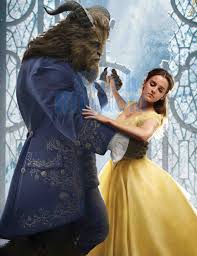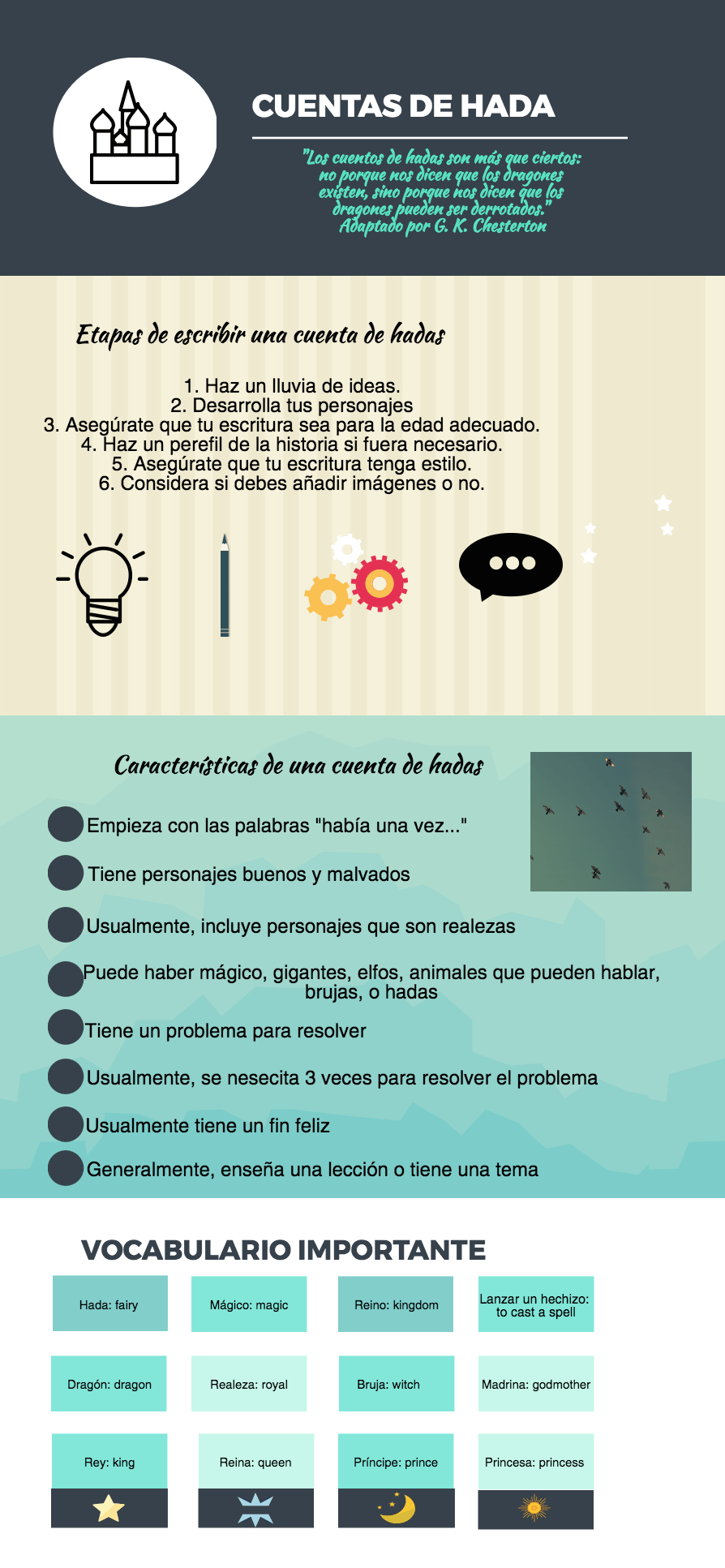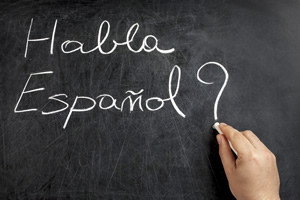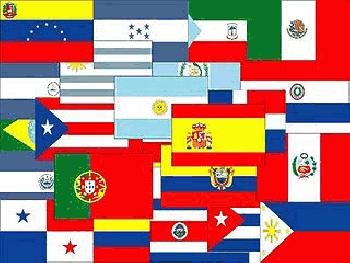
My practicum class size is small, with 13 students in the Spanish II classroom. The class is quite homogeneous, and there are no students with IEPs, or any special learning needs. The unit that I am focusing on is fairy tales, and the preterit and imperfect verb tenses. The students will use their textbook as a guide for the conjugation of the two tenses, and as a resource to learn how and when each tense is used. They will complete several activities on a website that accompanies the textbook. As an introduction we will watch the trailer for La bella y el bestia (Beauty and the Beast), and discuss fairy tales and fictional stories. I may also show the students libre soy which is the Spanish version of “Let it Go” from Frozen, to ignite further discussion about different types of fairy tales, and interpretations of stories. The students will also read a short how-to article that describes como escribir un cuento de hadas (how to write a fairy tale), and they will write their own fairy tale as a culminating assignment for the unit. We will read two different versions of “La princesa y el guisante” (“The Princess and the Pea”). The versions are not identical, and the students will be split into two groups, each group will read one of the versions, afterwards, they will be paired with a student from the other group and will re-tell the story to them, and discuss the differences between the two versions. The two versions of the story can be found here and here. After the students have read the two versions, we will watch a short film of the story.

Oscaravila. “Cómo Escribir Un Cuento Infantil,” WikiHow. WikiHow. 06 Mar. 2017. Web. 11 Mar. 2017.
Como escribir un cuento de hadas
This is a page from WikiHow, that gives some simple steps (in Spanish) for how to write a fairy tale. The article includes 6 steps for writing a fairy tell, as well as some points of advice at the end. The first step is to think of a LOT of ideas, the second is to to develop your personalities, third, make sure your writing can be understood by the appropriate audience, fourth, make a profile of the story, fifth, make sure that you have a clear style of writing, and lastly, consider if you should include images. Some of the pieces of advice include to keep in mind that many children’s stories end happily and to try to make your descriptions as vivid as possible so that the children can easily create pictures in their mind.
I think that this is an accessible text for the students. I could group the students into 6 groups and they could pick out the most important points of each of the steps to share with the class as a whole. The language may be slightly complex for the students, but they should be able to understand what is going on through the context. Some vocabulary words/phrases that can be found in this text include:
- Haz un lluvia de ideas: literally- make a rainfall of ideas, meaning- come up with a lot of idea
- Mangosta: mongoose
- Encajar: to fit
- Disfrutar; to enjoy
- Garabato: scribble/doodl
- Desglosar: to break down
- Lidiar: to deal with
- Apestoso: stinking
As for the quantitative measures of this text, the Fry chart said 10th grade level, the automated readability index, 4.6, and the Gunning fog index, 9.5. The average was 7.1. I am not sure if I agree with this or not. The text seemed that it was fairly easy to read, I would say that it would be geared for 6th grade and above, as far as native Spanish-speakers go. I think it is hard to determine a solid quantitative score for a text in Spanish because you cannot firmly say that it is for one grade or another for foreign language learners. The ability to understand the text depends on prior knowledge of the language, and a student in 9th grade can be at the same reading level in Spanish as a student in 12th grade, depending on when they started taking language classes.
I would use this text as an introduction to the unit. Students would need to activate their background knowledge about the structure of stories, fairy tales in particular. This text would also introduce the culminating project for this unit; writing a fairy tale, and this would hopefully get them motivated, and to start thinking about the kind of story they want to write, as well as give them tips for how to write the story. I think that this text would be fairly easy for the students to understand, and would work well with the task assigned for this reading.

Garcia, Javier. La Princesa Y EL Guisante (n.d.): n.pag. Espaciobook.com. Rincon Castalleno. Web. 11 Mar. 2017.
La princesa y el guisante
This is a version of “The Princess and the Pea” by Hans Christian Anderson, in Spanish. The story is about a prince who was looking for a true princess. All of the princesses that he had met thus far had something about them that did not seem quite right, and he refused to believe they were true princesses. One night, there was a terrible storm, and a princess came knocking on the castle door, she looked terrible. The queen was skeptical of this girl, and without saying anything to anyone, put a pea under 20 mattresses for the “princess” to sleep on. The next morning, when the queen asked the girl how she had slept, she said that she slept terribly, and it felt as though there were something very hard under her whole body. Upon hearing this answer, the queen knew that she must be a true princess. The prince married her, and put the pea inside of the new queen’s crown, and they lived happily ever after.
I think that this is a fairly accessible text. The format of the text is very straightforward, and is in a format that is familiar to students. Qualitatively, the language features are the most complex part of this text, mainly because the text is in Spanish. The students will need support throughout the reading to understand what the author is conveying. It is helpful to use a fairy tale in these classes, as many students may already be familiar with the story in English, and can more easily transfer what is going on due to their prior knowledge of the story. Some vocabulary words that the students might need support with include:
- Espantosa: horrific, hideous
- Golpear: to hit
- Tacón: heel
- Colchón: mattress
- Edredón: comforter
- Apenas: barely, hardly
- Joya: jewel
- Corona: crown
Quantitatively, I am not sure if I agree with the results I received, they never seemed to say the same thing. They Frey graph put this story at a 10th grade level, while Flesch-Kincaid said 7.9 and the Gunning fog, 11.1. The average of all of the scores was 8.4. I am not sure if this is due to the fact that the text is in Spanish, but I do not think that native speakers would use this text in the middle or high school setting. For native-Enlgish speakers, I think this is a great text for a level 2 Spanish course, no matter what grade the students are in.
The purpose of this story is to get the students reading an authentic text, assess their comprehension skills, and understanding of grammatical structures and uses. Throughout the story, the students will analyze the two verb tenses that they are currently learning (the preterit and imperfect). There are many examples of these types verbs throughout the text, and they will be able to explain why the certain tense is used in a certain phrase. This text will be used further understanding of literature and grammar. Because this story may be familiar to students, it is activating their prior knowledge, I think that fairy tales are fun to read, and something like this may be more motivating to students than other text choices. I think that the text itself is slightly complex, but the task that is accompanying the text is straightforward, and more simple.

Pieres, Pilar. “LA PRINCESA Y EL GUISANTE.” Pilarpieras WordPress.com, 15 Mar. 2012. Web. 12 Mar. 2017.
Película: la princesa y el guisante
This is a short, animated video retelling “The Princess and the Pea.” In this telling of the story, the prince was looking all over the world for the perfect princess, but none of them fit what he imagined. After coming home from his long trip, he locked himself in his room for years, thinking that he would never find the princess of his dreams. One stormy night, a princess came knocking on the palace door. The king and queen let her in, and tried to convince the prince to meet her, but he would not listen. The queen told her son that she would give the girl a test to determine if she was a real princess. So that night, she stacked 20 mattresses and 20 blankets, and put a pea under the very bottom. In the morning, the king and queen asked the princess how she slept, and she said that she had slept terribly. She had passed the test! The prince met her, and they got married, and the pea was put into a museum for all to see.
I think that this might be the most complex text for the students. Because the voices are done by native speakers, they are talking quite rapidly. It is not always easy to understand what they are saying. I think that this is an appropriate text, however, because the students are able to follow along better with the visuals, and they will already be familiar with the story in Spanish. This text would be appropriate for young Spanish-speaking students, but fits to a level 2 foreign language Spanish course. This short video is full of good vocabulary word such as:
- Querido: dear, darling
- Desconocidos: the unknown
- Culpa: fault
- Recorrer: to travel around
- Empujar: push (empujada: pushy)
- Enfadado: angry
- Esta nunca falla: this never fail
- Hambriento: hungry
- Por el fín, personas gritando “VIVA”: A Spanish custom at weddings or special events, the crowd/audience/attendees shout “viva” or “life,” to communicate good wishes.
I would use this text as a way to start wrapping up the unit. The students will watch the video, and will try to look for and write down the preterit and imperfect verbs that they hear. I will also stop the video a few times to ask questions to gauge their understanding, and clarify any points they have questions about. This task matches the complexity of the text because the text is more complex. The students will also be able to think more about the fairy tales that they are going to write, and may be able to use ideas from this short movie.
Additional sources:
Beauty and the Beast dancing
The Princess and the Pea image








